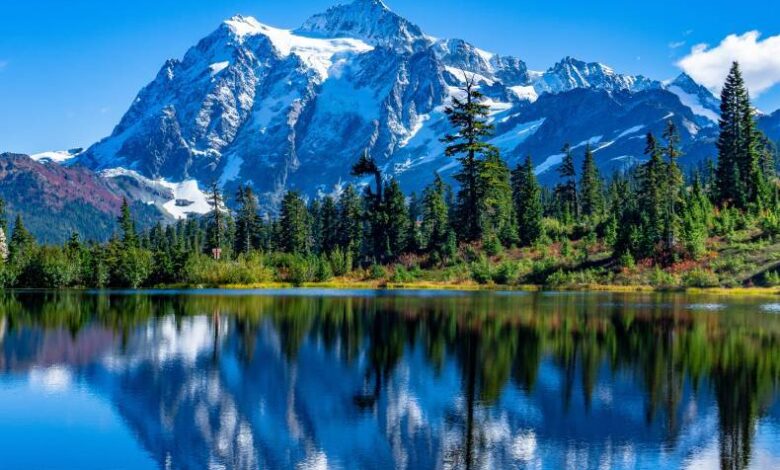Exploring the Diverse Landscape of Colorado

Colorado is a state known for its stunningly diverse landscapes, ranging from towering mountain peaks to expansive high plains. It’s a haven for outdoor enthusiasts, nature lovers, and those seeking breathtaking vistas. Several distinct geographical regions divide this dynamic state, each offering unique scenery and attractions.
The Rocky Mountains: A Majestic Backbone
The Rocky Mountains, which bisect Colorado from north to south, are the state’s most iconic geographic feature. This mountainous region includes some of the highest peaks in the continental United States, with Mount Elbert standing as Colorado’s tallest at 14,440 feet. These “Fourteeners” (peaks over 14,000 feet) attract hikers, climbers, and adventure seekers year-round.
The Rocky Mountains are also home to alpine lakes, dense forests of pine and aspen, and an array of wildlife including elk, mountain lions, and bighorn sheep. In winter, the Rockies transform into a wonderland for skiing, snowboarding, and snowshoeing, with world-class resorts like Aspen, Vail, and Breckenridge drawing visitors from around the globe.
High Plains and Prairie Lands
Eastern Colorado offers a stark contrast to the mountainous regions. The high plains stretch across the eastern third of the state, characterized by flat or gently rolling terrain. People often underestimate these plains, which are part of the greater Great Plains region of the United States, but they hold their own subtle beauty.
Fields of golden wheat and corn sway in the wind, providing vital contributions to Colorado’s agricultural economy. The plains offer wide-open skies that seem endless and are perfect for stargazing, showcasing spectacular sunsets, and experiencing the tranquil expanse of prairie life. Wildlife like pronghorn antelope, prairie dogs, and hawks are common sights in these areas.
Colorado Plateau and Desert Landscapes
To the west and southwest, Colorado transitions into the rugged terrain of the Colorado Plateau, marked by mesas, canyons, and dramatic red rock formations. The region showcases unique geological features shaped by millions of years of erosion.
Mesa Verde National Park, a UNESCO World Heritage Site, offers visitors a glimpse into ancient Puebloan culture through well-preserved cliff dwellings and archeological sites. Farther north, the Colorado National Monument displays stunning sandstone cliffs and rock spires that are a testament to the forces of nature. The desert-like conditions of the region provide a fascinating contrast to the state’s high-altitude environments.
San Luis Valley: A Hidden Gem
The San Luis Valley, nestled between mountain ranges, is one of the largest high-altitude valleys in the world. It is surrounded by the Sangre de Cristo and San Juan Mountains, creating an extraordinary setting. The valley is known for its agriculture, geothermal hot springs, and unique landscapes like the Great Sand Dunes National Park and Preserve.
The Great Sand Dunes are the tallest in North America, rising over 750 feet. Visitors can hike, sandboard, and marvel at the striking juxtaposition of sand dunes against the backdrop of snow-capped mountains.
River Valleys and Waterways
Colorado’s landscapes are further enriched by numerous rivers and streams that carve through mountains and valleys, offering vital water sources and recreational opportunities. The Arkansas, Colorado, and Rio Grande rivers are just a few of the waterways that have shaped the land over millennia.
River valleys, such as those surrounding the Colorado River, create lush areas for wildlife and offer recreational activities like rafting, kayaking, and fishing. These waterways not only define the landscape but also support Colorado’s ecosystems and communities.The community of Colorado can oftentimes bring unexpected criminal activity. If you find yourself involved in a crime, contact a Colorado criminal defense attorney.
Subalpine and Alpine Ecosystems
Colorado’s landscape is diverse even within its higher elevations. As visitors ascend, they encounter subalpine forests, dominated by spruce and fir trees, before entering the fragile alpine tundra above the tree line. In these high-altitude regions, wildflowers bloom in brilliant colors during the brief summer months, while hardy species like pikas and marmots adapt to harsh conditions.
Colorado’s landscape is a testament to nature’s artistry and geological forces. From majestic mountains and high plains to desert canyons and river valleys, the state offers an unparalleled array of environments. Whether you’re seeking adventure in the Rockies, solitude on the plains, or the beauty of red rock formations, Colorado’s diverse terrain beckons explorers to immerse themselves in its natural splendor.





